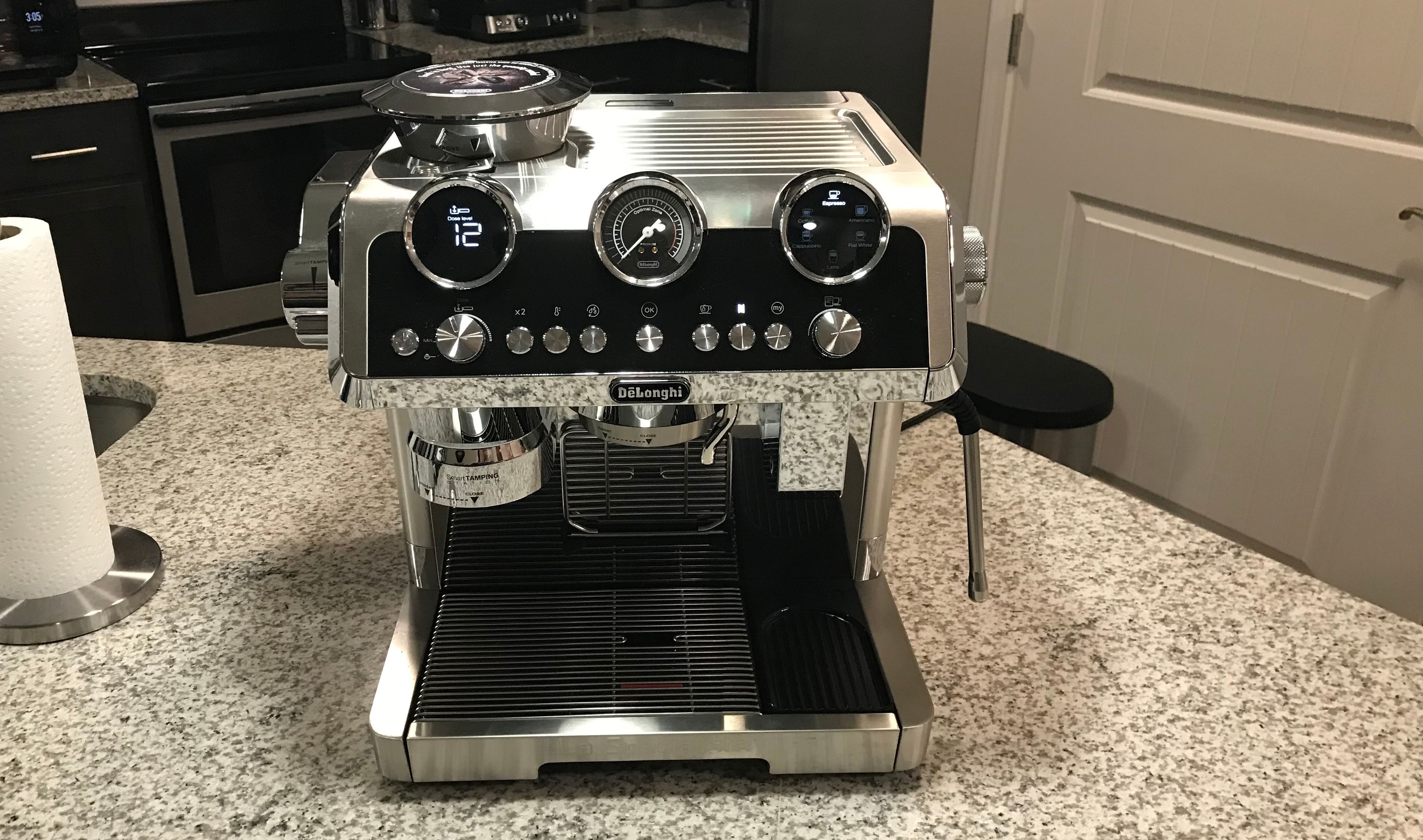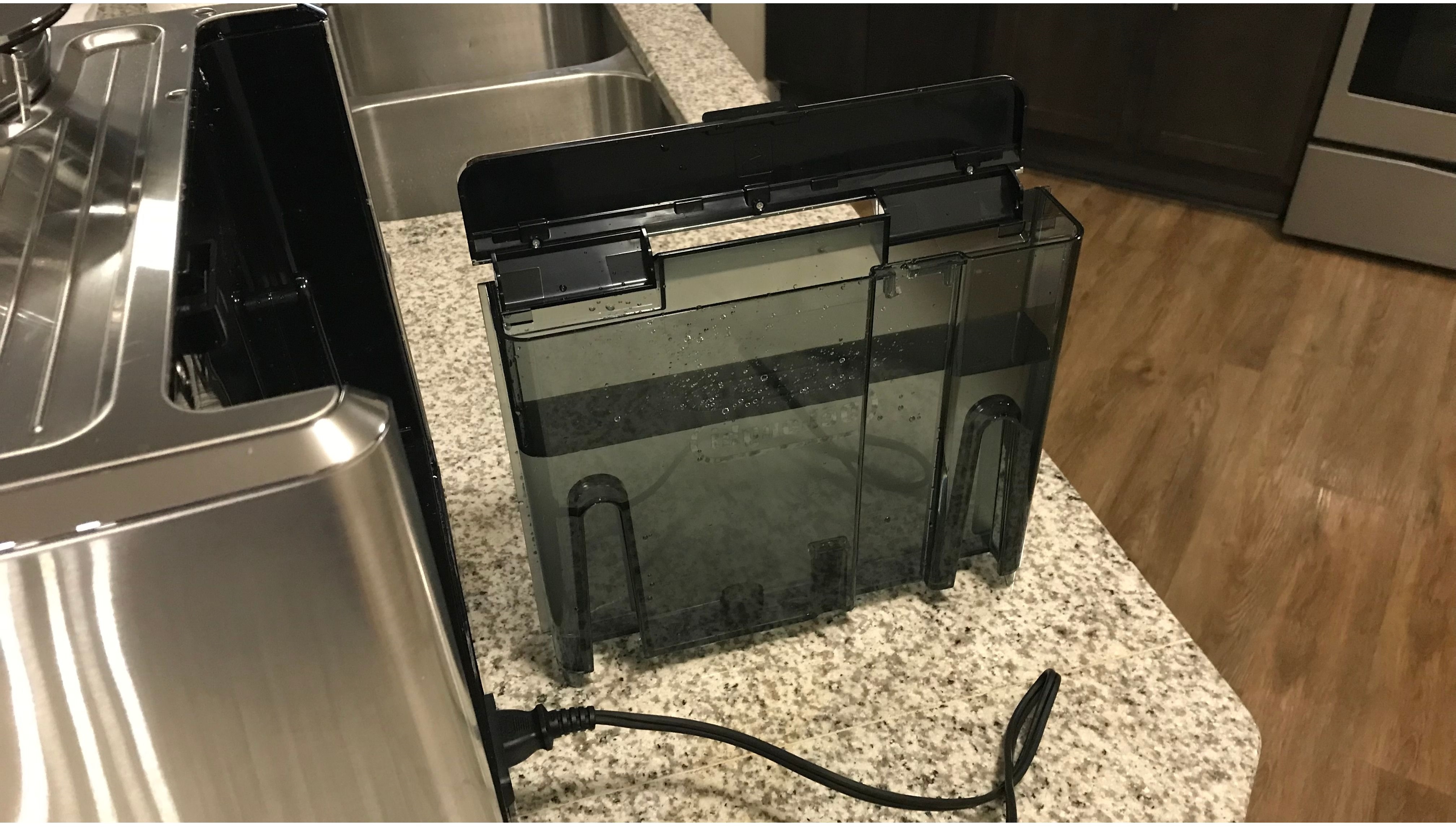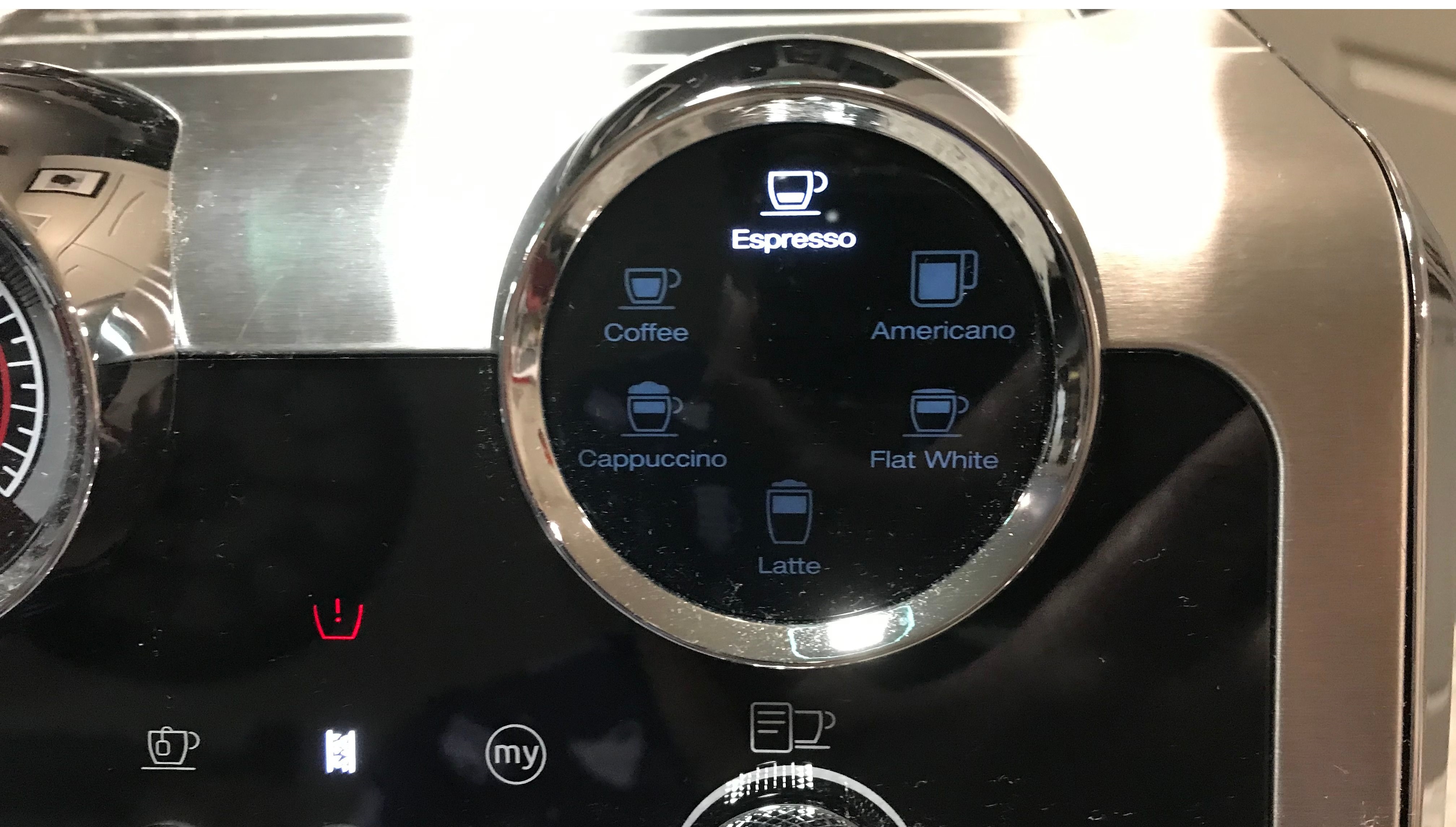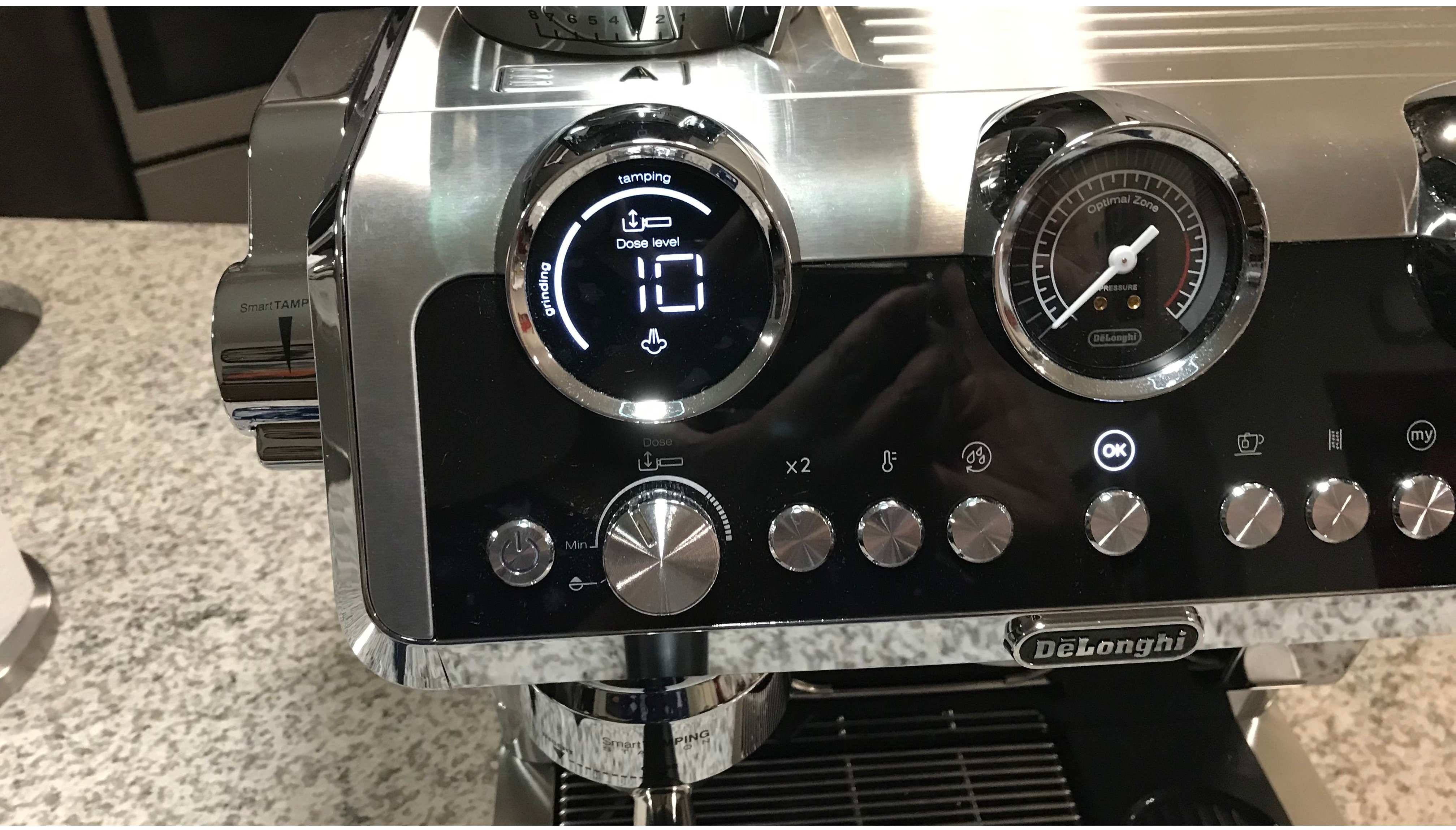De’Longhi is known for making some of the best coffee makers, with its line of automatic and manual espresso machines and collaboration with Nespresso machines. The De’Longhi La Specialista Maestro is the most expensive of the manual espresso machines but has the most bells and whistles.
For starters, it looks like one of the best espresso machines in a coffee house. Every component is made of stainless steel (aside from the black trim on the panel and bean hopper). The cup warmer on top and the three gauges (technically, only one is a true gauge, and the other two serve to display selections) add to the beautiful design.
But the De’Longhi La Specialista Maestro is as functional as a single-serve coffee maker as it is beautiful. Many espresso makers have a built-in grinder, but the Maestro goes the extra mile with broadly adjustable grind dosing settings (with eight levels) and suggested dosing ranges based on the roasting level. Smart tamping helps ensure the right dose and eliminates messy transfers.
The 19-bar high-pressure pump also has a gauge indicator, and the generous, removable water tank (67.6-ounce capacity) eliminates the need to keep refilling it. The machine makes coffee, Americano, espresso, latte, latte macchiato, cappuccino, and even hot water for tea or hot chocolate. In addition, the dual milk system lets me use the automatic LatteCrema system or manually use the latte art option.
At $1,399, the De’Longhi La Specialista Maestro is a high-end machine at a high price. However, the many features of this machine justify the price.

Terri is a freelance writer living in Birmingham, AL. She has tested hundreds of products, including kitchen appliances, vacuums, bedding, furniture, luggage, and tech gear. Terri has bylines at Architectural Digest, Forbes, Popular Science, CNN Underscored, NBC News, The Daily Beast, USA Today, US News & World Report, Tech Radar, Homes & Garden, and Tom's Guide. Follow her adventures @Territoryone.
Terri drinks (decaf) coffee daily and tested the De’Longhi La Specialista Maestro Espresso Machine on and off for several months, evaluating design, user-friendliness, flavor, and consistency. She was allowed to keep it for ongoing use
De’Longhi La Specialista Maestro: Key specs
| Row 0 - Cell 0 | Row 0 - Cell 1 |
| Type | Espresso |
| Pressure | 19bar |
| Capacity | 67.6 ounces |
| Bean hopper | 8.8 ounces |
| Average noise level | 50 dB |
| Dimensions | H18.5 x W16.5 x D14 inches |
De’Longhi La Specialista Maestro: Price & availability
The De’Longhi La Specialista Maestro Espresso is priced at $1,399.95 but is currently on sale for $1,250.00 at Amazon. It’s also sold direct-to-consumer at De’Longhi or through other retailers, such as Williams Sonoma.
De’Longhi La Specialista Maestro: Setup
I’ve had the De’Longhi La Specialista Maestro Espresso for four months, and as I recall, it was packed well to protect all components from damage. In addition to the machine, accessories include the stainless-steel milk frother carafe, single and double coffee filters, cleaning bush, descaler, water hardness test indicator paper, outlet cleaning disk, and cleaning cloth.
The power cord is removable, which makes it much easier to position the espresso machine flush against the wall if needed. There’s also a removable water tank (with a handle) in the back, which makes the container much easier to fill, pour out, and clean.
In my humble opinion, this is hands-down the most beautiful espresso maker I’ve ever tested. The design is so sleek and stylish, and the quality components make it look like a luxury product—granted, for the price, I would expect nothing less.
The beans container has a lid to keep the coffee beans fresh, and the burr grinder has an adjustable grind dose dial to accommodate various types of beans. In addition, the tamping feature helps to ensure the perfect dose. There’s a 1-cup coffee filter and a 2-cup coffee filter. Both have a laser mark inside to identify the level of coffee that produces a perfect dose. The ability to reach the perfect dose after tamping creates a great cup of coffee. It also helps me understand where I need to make changes. For example, if the coffee is at the right dosage level, but the coffee is pouring too slowly, then the grind needs to be coarser, and if it is pouring too quickly, it’s under-extracted, and the grind needs to be finer.
De’Longhi also takes other steps to ensure the perfect cup of espresso. For example, the water hardness test indicator paper determines the water hardness level. Then, the machine can be programmed so that the descaling light can come on more or less often, depending on the test results. A descaler is also included, which helps to remove minerals from hard water. In addition, a tube brush is included to clean the smart tamping station.
The drip tray, drip tray grille, and cup grill are dishwasher safe. However, the water tank, beans container, milk container, portafilter, and filters should be washed in the sink. After each use, the steam wand should be cleaned with a damp cloth, and using the steam function provides a deeper cleaner. When using the automatic milk feature, I can merely press the Clean button to clean it and then wash the milk container, spout, and intake tube in the sink (although these parts are dishwasher safe).
The espresso machine is a relatively large appliance, measuring 18.5 x 16.5 x 14in (h x w x d) and weighing 35 pounds, so it’s not something you’d keep moving around. It’s only available in stainless steel, but I can’t imagine it in another finish.
De’Longhi La Specialista Maestro: Performance
Before using, I washed all the parts, inserted the drip tray and cup grills into the machine, filled the water tank, and started a brew cycle to rinse out any steam (inserting a large container underneath to catch the water). Next, I moved the container under the portafilter and frothing wand, pressed the steam button, and opened the steam dial to clean that section.
After completing these tasks, I was ready to start testing the De’Longhi La Specialista Maestro. I added some beans to the hopper and set the grind level to 5, which is the factory setting (the range goes from 1 for fine to 8 for coarse). Here’s something to understand about the grinding process. There’s a knob on the beans container, and it can be turned to adjust the grind settings. However, don’t confuse this with the Dose Level gauge (the gauge on the far left side of the control panel). The numbers (from 1 to 30) shown on the Dose Level indicator are not the same as the grind setting. Instead, those numbers are suggested ranges based on the type of coffee beans used. For example, extra light corresponds to 1, medium corresponds to medium, 15 is for the medium dark range, 20 is a good range for dark, 25 is suggested for extra dark, and if extra-grinding is required, that would be in the 30 range.
After choosing the appropriate range, I inserted a filter into the portafilter, locked it into place, and started grinding. When the grinding stopped, I pulled the tamping level toward me, removed the portafilter, and attached it to the brewer.
The next step was brewing. The control panel includes a variety of buttons: On/Standby, coffee dose dial, X2 button for use with the two coffee filters, Coffee Temperature button, Active Rinse Button, OK/Confirmation button, Hot Water button, Descaling button, My/customization button, and Beverage Selection dial. The gauge on the far right side displays Espresso, Americano, Flat White, Latte, Cappuccino, and Coffee selections.
I selected an Espresso the first time. I selected a Cappuccino for the second drink using the manual frothing method. I filled the milk jug with milk, turned on the steam wand to ensure there was no condensation, and then placed the nozzle on the surface of the milk and then just under it. The third time, I selected a Cappuccino and used the LatteCrema System. I put the lid on the milk jug and selected my preferred froth level (using the knob on the lid, I can choose from no froth, minimum froth, and maximum froth). The milk container is then attached to the espresso machine, and the milk feature starts after the brewing cycle.
I appreciate various icons flashing as alerts if I’m doing something wrong or forgetting a step. For example, a cup/bean icon will flash if the bean container is empty, and the water pitcher icon will flash if there’s not enough water in the water tank or if the tank isn’t inserted correctly. Other icons appear or flash to remind me to clean the LatteCrema System after every use,
De’Longhi La Specialista Maestro: Taste Test
I used whole beans from Bluestone Lane and Zend Coffee when testing the espresso machine. I also used the De’Longhi dosing recommendations to help determine the grind settings based on whether I was using light, medium, or dark roasts. This helped to ensure the drinks would not be watery or too strong.
In addition, the Active Temperature Control has five profile settings that can be adjusted based on the type of bean. Each one provides a different temperature rate for brewing and flavor infusion. The pre-infusion function ensures the grounds are evenly wet, based on density, for a perfect extraction. These are the features that contribute to rich and flavorful drinks.
Admittedly, I’ve tested several De’Longhi espresso machines, which’re almost foolproof. So, in my experience, you have to try hard to have a bad experience that doesn’t result in flavorful coffee. It’s never bitter, sour, or acidic.
I like milk and sugar, so I prefer a latte or cappuccino to an espresso. During my testing, those drinks were more appealing—actually mouth-watering—but the espresso drinks were flavorful as well.

Should you buy the De’Longhi La Specialista Maestro?
Buy it if...
Don't buy it if...
How does the De’Longhi La Specialista Maestro compare?
The Seattle Coffee Gear Diletta Bello+ Espresso Machine is an unusual-looking contraption that makes high-quality espresso drinks. However, it does not have a built-in burr grinder, and at $1,899, it’s even more expensive than the De’Longhi La Specialista Maestro.
The Breville Barista Touch ($1,499.95) has many of the same features as the De’Longhi, including a coffee bean grinder and a guided touch screen. However, the milk frother is manual.
How I tested the De’Longhi La Specialista Maestro
- Tested for four months, alternating between the various types of drinks
- Tested with a variety of coffee beans
I tested the De’Longhi La Specialista Maestro for several months, off and on. I have a massive kitchen island that can hold several appliances, so sometimes, I would put it aside and then come back to test it again. When testing, I evaluated build quality, ease of use, performance, ease of cleaning, and, of course, taste.
Read more about how we test.
- First reviewed: February 2024





